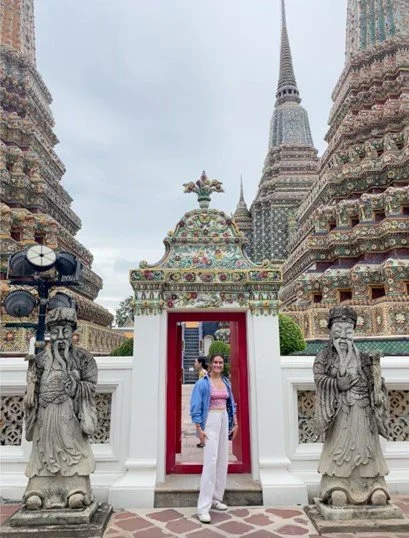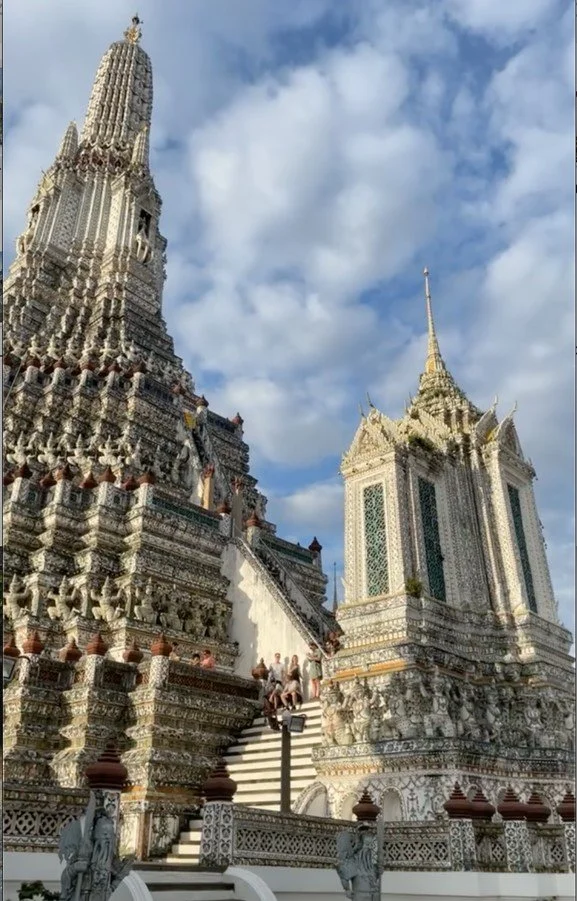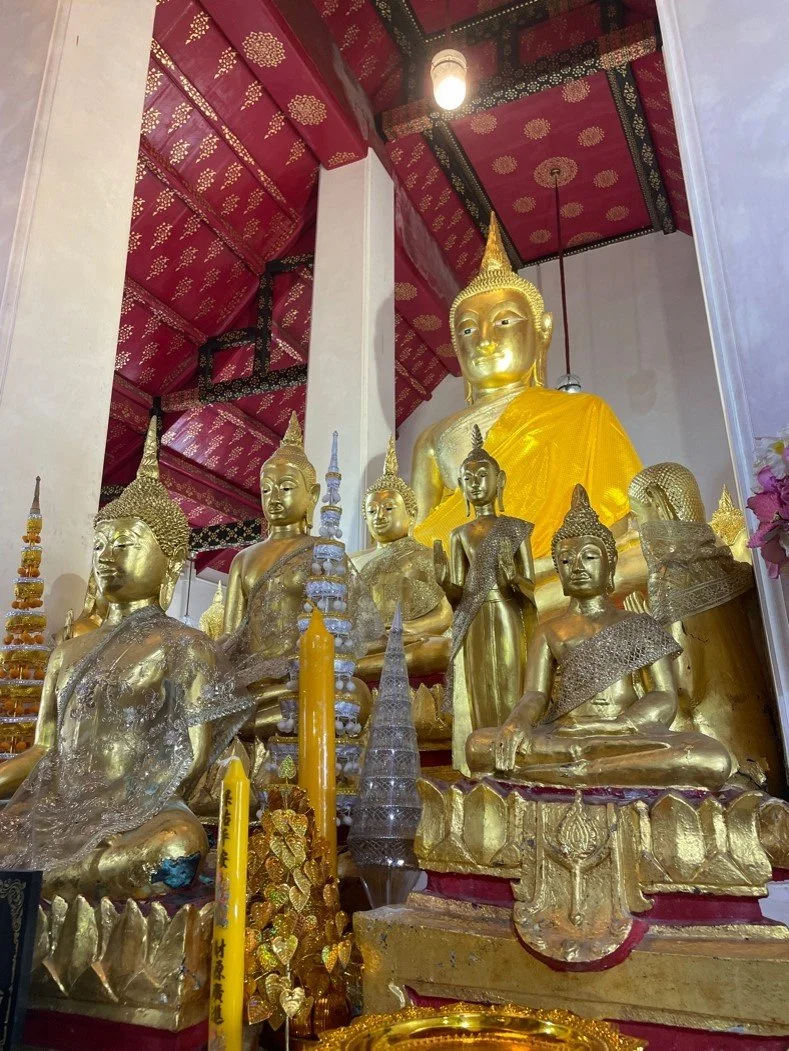The Foundations of Dawn: Exploring Thai Buddhist Architecture as a site of cultural exchange with reference to Wat Arun, Bangkok.
BY RACHAEL THORP
Thai Buddhist architecture promoted cultural exchange and reinforced the political legitimacy of the Thai elite. Throughout history, Buddhist temples in Thailand played host to political, royal, and diplomatic influences that influenced their architecture. This analysis of Wat Arun aims to dispel misconceptions about the foreign origins of Buddhist architectural styles and their socio-political objectives. It explores how Wat Arun, or the Temple of Dawn, went beyond its religious function to support Thai nationalism, economic prosperity, and royal authority during its renovation in Bangkok between 1782 and 1851 coinciding with the establishment of the Rattanakosin Kingdom.[1] Wat Arun exemplifies the versatile design of Buddhist temples and their role in legitimizing power structures within Thai society, initially unrelated to the Buddhist faith.[2] By identifying the origins and implications of Wat Arun’s architecture, the article aims to reveal the symbols of hybridisation of Thai popular religion, the consolidation of monarchical authority, and the memorialisation of transnational trade within Buddhist material culture.[3]
The conscious incorporation of Hindu deities and structural styles into Buddhist architecture reflects the increased trading, and the exchange of ideas between Southeast Asians and Indian culture. Despite assertions that Thai Buddhism endured a period of ‘Hinduisation’, the prevalence of Hindi figures and structural influence in Buddhist architecture is not representative of Hinduism as a religious, intellectual, or theological system of worship in Thailand.[4] These economic shifts explain the localisation of Hindu vocabulary, and literature.[5] In contrast to other Southeast Asian countries, Siam built a consistent mercantile connection with India, providing a transmission route for Brahmanical teachings.[6] In contrast to theoretical distinctions between canonical Buddhism and non-Buddhist components of Thai ritual, historians such as Tambiah have concluded that Buddhism and Hinduism do not function as religious dichotomies but are inextricably connected.[7] Although the Buddhist lay majority frequently present gifts to ‘Hindu’ shrines across Bangkok, there is minimal philosophical understanding surrounding the ritual or liturgy of Hinduism by contemporary Thai Buddhists because Hindu statues and literature are understood to be a constituent part of the Buddhist temple.[8] Although Hindu texts are standard within Buddhist literature, these liturgies are not included within the religious ritual commitments or expectations but rather as an element of academic education.[9] Thus, the tendency of Western scholarship to categorise and subdivide canonical Buddhism and Hinduism through texts rather than rituals created a pseudo-problem in the role of Hinduism in Buddhist architecture.[10]
The amalgamation of Hindu-Buddhist worship architecture in Thai Buddhist Architecture: Origins and effects
The incorporation of Hindu deities and structural styles into Buddhist architecture reflects the increased trading, and the exchange of ideas between Southeast Asians and Indian culture. Despite assertions in scholarly literature that Thai Buddhism endured a period of ‘Hinduisation’, the prevalence of Hindi figures and structural influence in Buddhist architecture is not representative of Hinduism as a religious, intellectual, or theological system of worship in Thailand.[11] These economic shifts explain the localisation of Hindu vocabulary, and literature.[12] In contrast to other Southeast Asian countries, Siam built a consistent mercantile connection with India, providing a transmission route for Brahmanical teachings.[13]
In contrast to theoretical distinctions between canonical Buddhism and non-Buddhist components of Thai ritual, historians such as Tambiah have concluded that Buddhism and Hinduism do not function as religious dichotomies but are inextricably connected.[14] Although the Buddhist lay majority frequently present gifts to ‘Hindu’ shrines across Bangkok, there is minimal philosophical understanding surrounding the ritual or liturgy of Hinduism by contemporary Thai Buddhists because Hindu statues and literature are understood to be a constituent part of the Buddhist temple.[15] Although Hindu texts are standard within Buddhist literature, these liturgies are not included within the religious ritual commitments or expectations but rather as an element of academic education.[16] Thus, the tendency of Western scholarship to categorise and subdivide canonical Buddhism and Hinduism through texts rather than rituals created a pseudo-problem in the role of Hinduism in Buddhist architecture.[17]
The structural and decorative design of the Temple of Dawn aims to convey the aesthetic of Braham and Hindu literature. Specific elements of the temple, such as its name Wat Arun, originate from the Hindu God Aruna.[18] The wat is built on a common terrace supporting the central prang, the four side mondop and the four-surrounding prang.[19] The square mandala outlined in figure 1 illustrates the five towers and four alters that comprise Wat Arun’s square mandala layout. The mandalas are symbolic of the Hindu god’s concentric universe, masculinity and absolute order indicating the motives behind King Rama’s renovation of Wat Arun during his pursuit of monarchical consolidation.[20] The imposing central prang represents the Sumeru Mountain described in the Hindu universe, whilst the four towers embody the four great continents.[21] The subdivisions of the central prangs façade into four tiers that reflect the formless realm of Antariksa in Hindu literature.[22] The temple’s structure illustrates the amalgamation of Hindu literature into the Buddhist pantheon. These structural features serve monarchical consolidation and align Thai religion with power, order, and authority rather than asserting definite ritualistic instruction. Wat Arun’s architectural association with Hinduism continued to increase throughout the nineteenth century. The Phra Prang central tower was rebuilt by King Rama III between 1842 and 1847, from its original 16 metres to 67 metres high.[23] Similarly, the embellishment of the temple’s exterior reflects the fusion of Hindu narratives into Buddhist architecture.
Hindu figures have been amalgamated into the Buddhist pantheon and represent historical or divine figures alongside the historical Buddha as mythical deities. Their narrative role was introduced into Thai architecture to legitimise the social hierarchy.[24] The base is an octagon, surrounded by a four-story platform, with stone steps on all four sides (fig.2).[25] The central prang's second and third tiers depict Kinnara and Kinnari figures with Brahmin celestial bearers.[26] Similarly, on the fourth terrace of the prang, the four highest alcoves contain a statue of the Hindu God Indra, the ruler of the Travatimsa heaven riding the three -headed elephant, Erawan.[27] The stark monumental symbolic form of Wat Arun marks a decisive illustration of the literary diversity, and cross-cultural exchange of religious texts between the Thai intellectuals and Indian Hindu culture as a source of unity and legitimisation of the Thai social hierarchy.
In conclusion, the assertion of monarchical authority, the memorialisation of diplomatic pursuits, and the conflation of religious Hindu-Buddhist cultures has moulded Bangkok’s Buddhist architecture into sites of significant cultural exchange. Wat Arun undoubtedly functions as a site of cultural exchange. It embodies a microcosm of Siamese society in the late eighteenth and early nineteenth century. The embellishment of the prangs highlights the integration of Hinduism’s deities and narratives into Buddhist conceptions of the monarchy’s divine power to rule.[28] Similarly, the veneration of the monarch through engraved royal seals, investment in construction, and the role of King Rama I and II in designing the temple reflects the significant function of Wat Arun as a physical manifestation of the monarchy’s consolidation of power. In the period of centralisation succeeding the transfer of the capital to Bangkok, the Chakri dynasty immortalised and consolidated the Siamese kingdom in the architecture of Wat Arun. [29] Resultantly, it became a symbol of monarchical authority and a celebration of successes associated with Bangkok. Bangkok’s temples in the early nineteenth century were not simply spaces of worship. They served as projections of the political and social climate of this period. Wat Arun divinified the monarch, his political authority, and the economic and cultural successes that could be attributed to his court.
[1] John Villers, “A New Capital for a New Dynasty: Bangkok from Rama I to Rama III (1782–1851)”, The Court Historian, 17:2 (2012),137-153.
[2] Chris Baker, and Pasuk Phongpaichit, A History of Ayutthaya: Siam in the Early Modern World, (Cambridge Press, 2017), 272.
[3] Pattana Kitiarsa, “Beyond Syncretism: Hybridization of Popular Religion in Contemporary Thailand.” Journal of Southeast Asian Studies 36.3 (2005): 461–487.
[4] McDaniel, “This Hindu Holy Man is a Thai Buddhist”, 191-209.
[5] Oliver William Wolters, History, culture, and region in Southeast Asian perspectives, rev. ed. (Cornell, 1999), 60-63.
[6] Bhaswati Mukhopadhyay "Brahmanical Divinities in Siam: From Early to Modern Era." In India-Thailand Cultural Interactions (ed) Lipi Ghosh, (Singapore, 2017), 29.
[7] Stanley Tambiah, Buddhism, and the Spirit Cults of North-East Thailand (Cambridge: Cambridge University Press, 1970), 330.
[8] McDaniel, “This Hindu Holy Man is a Thai Buddhist”, 191-209.
[9] Ibid, 191-209.
[10] Nathan McGovern, “A Buddhist Cult of Brahmā: Thick Description and Micro-histories in the Study of Religion.” History of Religions 55.3 (February 2016): 329–360.
[11] McDaniel, “This Hindu Holy Man is a Thai Buddhist”, 191-209.
[12] Oliver William Wolters, History, culture, and region in Southeast Asian perspectives, rev. ed. (Cornell, 1999), 60-63.
[13] Bhaswati Mukhopadhyay "Brahmanical Divinities in Siam: From Early to Modern Era." In India-Thailand Cultural Interactions (ed) Lipi Ghosh, (Singapore, 2017), 29.
[14] Stanley Tambiah, Buddhism, and the Spirit Cults of North-East Thailand (Cambridge: Cambridge University Press, 1970), 330.
[15] McDaniel, “This Hindu Holy Man is a Thai Buddhist”, 191-209.
[16] Ibid, 191-209.
[17] Nathan McGovern, “A Buddhist Cult of Brahmā: Thick Description and Micro-histories in the Study of Religion.” History of Religions 55.3 (February 2016): 329–360.
[18] Bhaswati Mukhopadhyay, "Brahmanical Divinities in Siam: From Early to Modern Era." In India-Thailand Cultural Interactions (ed) Lipi Ghosh, (Singapore, 2017), 30.
[19] Clarence Aasen, Architecture of Siam: A Cultural Interpretation, (Oxford, 1998), 130.
[20] Wu Tong and Yakun Guo, "Analysis on Architectural Aesthetic Dimensions of the Temple of the Dawn Complex." IOP Conference Series. Earth and Environmental Science 567, no. 1 (September 2020), 2.
[21] Tong and Guo, "Analysis on Architectural Aesthetic Dimensions of the Temple of the Dawn Complex.", 2.
[22] Ibid, 3.
[23] Aasen, Architecture of Siam: A Cultural Interpretation, 130
[24] McDaniel, “This Hindu Holy Man is a Thai Buddhist”, 191-209.
[25] Tong and Guo, "Analysis on Architectural Aesthetic Dimensions of the Temple of the Dawn Complex.", 2.
[26] Aasen, Architecture of Siam: A Cultural Interpretation, 131.
[27] Ibid, 131.
[28] Bhaswati Mukhopadhyay, "Brahmanical Divinities in Siam: From Early to Modern Era." In India-Thailand Cultural Interactions (ed.) Lipi Ghosh, (Singapore, 2017), 30.
[29] Villers, “A New Capital for a New Dynasty: Bangkok from Rama I to Rama III”, 137-153.
ST.ART does not own the rights to any image used in this article




